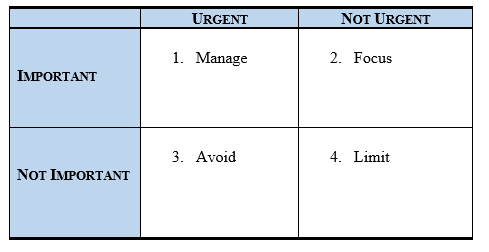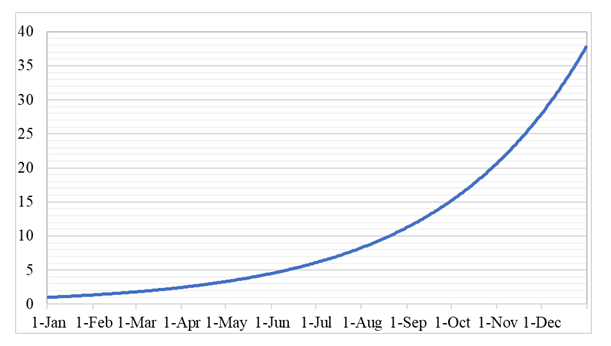Early in my career at the University of Maryland, I was asked to run a workshop on project management fundamentals for a campus group. Much to my surprise, when we opened the Q&A session, many of the questions had nothing to do with PM basics but rather on how to manage their time! Not the project schedule, but individual time management!
So, I started to incorporate the topic into my PM fundamentals presentations and over the years the presentation has evolved. Below is a 42 minute webinar on Time Management presented by John Cable, Director of the Project Management Center for Excellence.
Below is an article about what is shown in the video above.
Time is fixed. There are 24 hours per day, 7 days a week, etc. and each week contains 168 total hours, no more, no less. So, if you sleep 8 hours each night, there are 112 hours left in the week. What do you do with them? It is up to you to use them efficiently and wisely!
If you want to be deliberate about how you spend your time, you must develop a system of time management that works for you. Book stores usually have dozens of books on managing your time and each author assures you that their system really works! And, it probably does for them. But you are not them! Your only hope is to design a system that works for you.
So, let’s agree that your objective is to build the necessary capacity for you to reach and sustain a high level of individual performance in the face of increasing demand!
Let’s begin by doing an exercise that can help put things in focus. The following table allocates time into broad categories that we have national averages for. Complete this for yourself to see where you stand.
Table 1: Weekly Time Allocation in Hours

Are there any surprises? Do your totals add up to more than 168? Are any areas underfunded? Looking at how you spend your personal time this way, are there any changes you want to make? Are you spending your time according to your values and priorities? Your distribution is going to be different than the national averages, that column simply provides you a reference point.
Think about this information for a while and let it sink in. While you are doing that, let’s have a look at how we use our time while working. Stephen Covey in his book “The Seven Habits of Highly Effective People” presents us with a way to think about the time we spend at work. He suggests allocating your work hours into a 2 x 2 matrix.
Table 2: Weekly Work Time Allocation in Hours

Quadrant 1 includes activities that are important, essential, customer escalations, and short-term crises. This is important stuff, but we want to manage it and not let it dominate our time.
Quadrant 2 includes activities that are not urgent but are indeed very important such as planning, organizing, managing others, customer relations, and continuous improvement.
In an ideal situation this is where we want to spend most of our time.
Quadrant 3 includes activities that are urgent but not important. We want to avoid them. They include interruptions, other people’s problems, unnecessary emails, meetings, and phone calls. Irritating things that we can clearly do without.
Quadrant 4 activities are not urgent and not important. They might include busy work, various delaying tactics, escape activities, emails, meetings, and training. You want to actively work to minimize this category but some of it may be necessary.
This framework is also applicable to your personal time but for this article we are using it to focus on time at work. Are you spending time the way you want to? Are you working by your priorities and values? Can you be more efficient and productive if you reorganize how you spend your time?
While you mull over the results of your analysis in tables 1 and 2, there are three things to think about as you plan how you are going to manage your time. They are your Energy, Time Horizons, and Habits.
ENERGY
The first is energy. Your energy! We all have a curve of our daily energy ebbs and flows, and we are each different. Some of us are morning people, some get a lot done in the afternoon, and others are night owls. Here is an example of what an energy curve might look like, yours may be quite different:

If we know and understand our daily energy curve, we can plan our activities to take advantage of it; your actual daily energy is impacted by several variables. Getting enough sleep is a starting point, but exercise, eating habits, time for private thought and reflection are but some of the many variables. If you need to push through a time when your energy is getting low, indulging some protein – not candy – will certainly help you refocus.
The main point I want you to consider when you are planning how to manage your time is to embrace your natural energy flows and work with them. Do the most complex activity at times of peak energy. Do the routine things, like answering email, in times of low energy. If you start to get sleepy, get up and walk around and do some relationship building, either in person or on the phone / video conference. Reserve time to have meetings at times that do not take as much energy as complex problem solving does.
TIME HORIZONS
The second consideration is planning your time using multiple time horizons. Plan your calendar thinking about annual, quarterly, monthly, weekly, and daily horizons. Allocate your time according to your priorities for family, work, personal and community spheres of influence. Planning with short term, mid-term, and longer-term time horizons enables you to make sure you get things done when they need to be and they are not an afterthought or forgotten. Long term planning helps achieve your goals.
HABITS
The third consideration is our habits. The book “Atomic Habits” by James Clear is an eye-opener that will give you a much better understanding about how our brain works and how to change habits that we want to change. Some of my notes from reading this book include:
- Your habits can compound for or against you.
- Forget about goals and focus on systems instead.
- Winners and losers have the same goals.
- Achieving a goal is only a momentary change.
- In order to improve for good, you need to solve problems at the systems level.
- Fix inputs and the outputs will fix themselves.
- Ultimately, your commitment to “process” will determine your progress.
- There are 3 layers of behavior change: Outcomes / Processes / Identity
- Build identity based habits – focus on who we wish to become!
- A habit is a behavior that has been repeated enough times to become automatic.
And this is my favorite:
- Tiny changes can make a BIG difference – 1% better everyday compounds to 37 times better at the end of one year! Check out this graph.
365 Day Improvement by 1% Daily

Your new plan is very likely going to require new habits. We can, in fact, change our habits if we want to and we discipline ourselves to repeat the desired behavior until it becomes habit! So, when you design your time management plan, you can make major changes depending on how you think about it and the commitment you make. Do read James Clear’s book because it will change how you think about habits.
Thus far we have talked about the big three, Energy, Time Horizons, and Habits. Now we want to move to the action plan. The Action Plan also has three components: Master the Basics, Set & Achieve meaningful goals, and Make the Change!
MASTER THE BASICS
Start with simple and small wins. Keep a time log for one week. Think about what you learned in the weekly work time allowances exercises above. Group activities by like types. Look for ways to simplify and group large chunks of time. Know your energy curve. Plan using multiple time horizons and be sure to include quiet time. Learn to say NO! Make effective use of waiting time – I always carry something for notes and reading, the iPad serves both purposes. Try to handle paperwork only once.
SET & ACHIEVE MEANINGFUL GOALS
Plan your annual goals and objectives and be sure to use short, medium (look-ahead), and long-term planning horizons. Set your priorities using the four spheres of family; work; personal; and community. Refine your plan and use varying degrees of detail as needed and appropriate. The further away on the time horizon the less detail desired.
At the end of each week, think about what worked and where you have areas for improvement. Do not be afraid to change and adjust your plan! You must find something that works for you.
MAKE THE CHANGE!
Plan your schedule using everything you have learned plus being consistent with your priorities. Plan blocks of time for important items and plan how to alter your behavior to enhance your system. Train others about your system. My experience is that your boss, peers, and subordinates generally will work with you to implement your system. Keep weekly records and pay attention to time utilization.
Do not waste other people’s time and do not let them waste yours. Be polite and respectful but persevere. You now have a system. Implement and refine it as appropriate. As your life and work circumstances change, you will need to revisit your time management plan and make adjustments.
Efficient time utilization takes work, stay with it until it becomes habit. Always look for ways to improve. Am I using my time wisely? Is there something more important I should be doing? Is there a better way to do this? Do I need to do it at all?
This is a lifelong journey, it is not “Once and Done”. Remember to re-adjust as things change in your life. Keep at it and it will enhance your productivity!
John Cable, Director of the Project Management Center for Excellence, presented a 42 minute webinar on Time Management. Watch the video below.
Posted by Kathy Frankle on March 12, 2021

 Data Analytics for the Project Manager
Data Analytics for the Project Manager